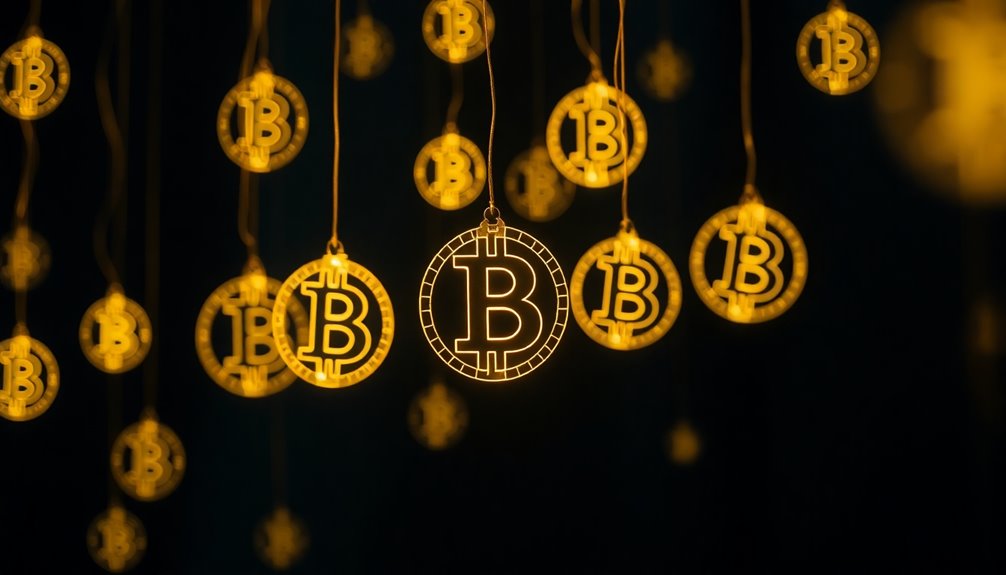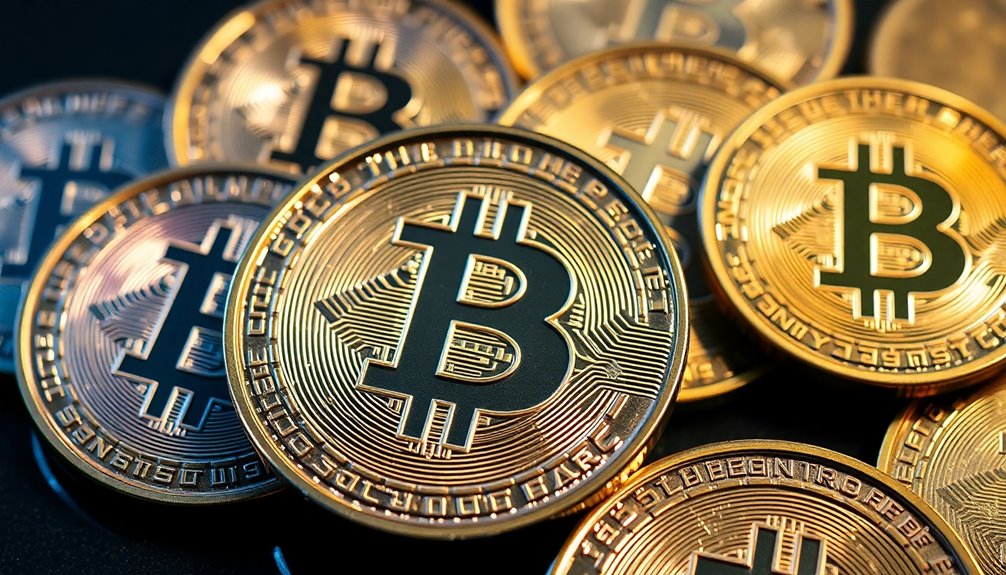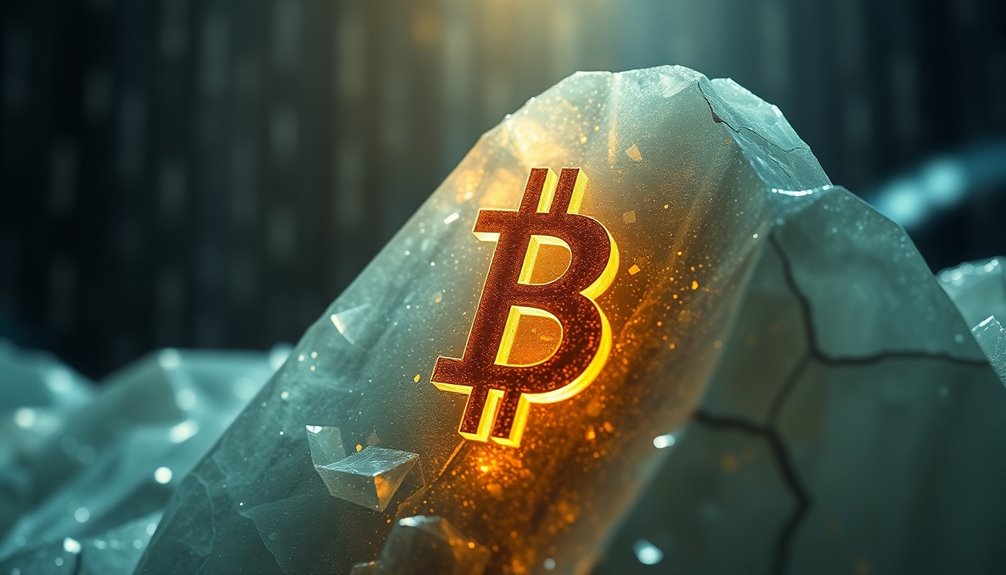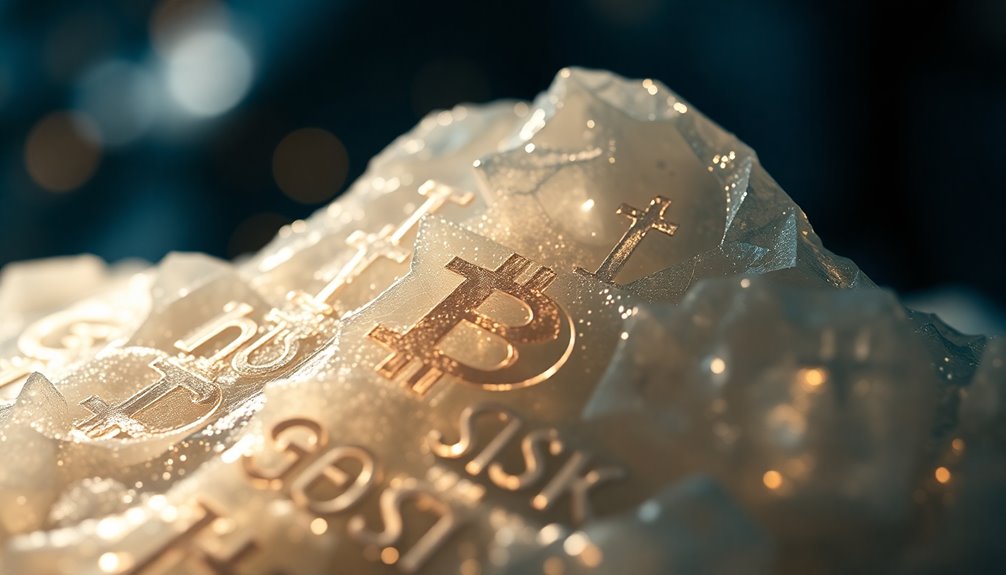Bitcoin Runes are an innovative method for transaction verification on the Bitcoin network, introduced by Casey Rodarmor in September 2023. They've been designed to boost scalability and speed, making it easier for you to create and manage fungible tokens. With Bitcoin Runes, you can trade tokens directly on the Bitcoin blockchain without the complications of smart contracts. Plus, they streamline storage needs and enhance overall security. While there are advantages, some challenges also arise. Want to uncover more about how Bitcoin Runes change the landscape of digital transactions and their future potential?
Key Takeaways
- Bitcoin Runes are a new method for transaction verification on the Bitcoin network, enhancing scalability and speed.
- They simplify the creation and transfer of fungible tokens, reducing junk UTXOs and improving operational efficiency.
- Bitcoin Runes utilize the UTXO model and the OP_RETURN opcode for efficient metadata storage without complex smart contracts.
- They incorporate advanced security measures, including cryptographic algorithms and recommended practices like cold wallets and Two-Factor Authentication.
- The future of Bitcoin Runes looks promising, with potential for integration and increased adoption in the digital economy.
Key Concepts of Bitcoin Runes

When you dive into the world of Bitcoin Runes, it's essential to grasp a few key concepts that underpin their functionality.
The UTXO model forms the backbone of Bitcoin transactions, where unspent transaction outputs represent your usable Bitcoin. Each transaction consists of inputs and outputs, with leftover outputs becoming UTXOs for future use. Bitcoin Runes allow the creation of fungible tokens on the Bitcoin blockchain, expanding the possibilities within the ecosystem.
Using UTXOs streamlines token management and eliminates complex smart contracts. Additionally, the OP_RETURN opcode lets you store small amounts of arbitrary data in transactions, perfect for metadata related to Runes.
This non-spendable data, like runestones, serves purely for informational purposes. Understanding these concepts ensures you navigate the Bitcoin Runes landscape effectively, making the most of this innovative token system.
Understanding Bitcoin Runes

As you explore Bitcoin Runes, it's crucial to understand their definition and how they operate within the Bitcoin blockchain.
Introduced by Casey Rodarmor in September 2023, Bitcoin Runes were activated on block 840,000 in April, aiming to simplify the creation, minting, and transfer of fungible tokens. The Runes protocol aims to reduce junk UTXOs, making it more efficient. Unlike the BRC-20 standard, Runes address issues like excessive "junk" UTXOs, making it more efficient. The first Rune token, $RUNE, launched on the announcement day, highlighting market interest.
By utilizing OP_RETURN for storage, Runes ensure efficient data management, reducing size to 80 bytes.
Mechanism of Transaction Validation

To understand how Bitcoin Runes validate transactions, you need to grasp the intricate process that ensures each transaction is legitimate and secure.
First, inputs must be unspent and verified against the UTXO set to prevent double-spending. If valid, the transaction proceeds to check the digital signature, confirming the sender's ownership of the coins.
Next, nodes broadcast the transaction across the network, where miners and other nodes verify it against network rules. After miners solve complex problems, they add the transaction to a block, which is then linked to the blockchain. This process of verification involves checking the sender's balance and ensuring compliance with Bitcoin protocol, which enhances the overall security of the network.
This connection provides additional confirmations, with more blocks serving as proof of legitimacy. Thus, each step safeguards the integrity of Bitcoin Runes transactions.
Pros and Cons Overview

While Bitcoin Runes offer innovative solutions for token creation on the Bitcoin blockchain, they also come with their share of advantages and disadvantages.
On the plus side, they simplify token creation, reduce storage needs, and enhance security, all while operating efficiently on-chain. This resource efficiency can lead to better scalability and user experience, attracting a broader audience. Additionally, the UTXO-based fungible tokens model allows for streamlined interactions that can further enhance user engagement.
However, the complexity of the system may pose challenges for everyday users, requiring technical know-how that some might lack. Additionally, widespread adoption could increase transaction fees and network congestion, impacting efficiency.
Security concerns and potential regulatory issues also linger, which could hinder growth and acceptance. Balancing these pros and cons is essential for anyone considering Bitcoin Runes.
Bitcoin Runes vs. Traditional Bitcoin

Although traditional Bitcoin serves as a robust store of value and medium of exchange, Bitcoin Runes introduce a new layer of functionality that expands its potential.
Runes allow you to create and trade fungible tokens directly on the Bitcoin blockchain without needing off-chain data or native tokens. Operating within Bitcoin's UTXO model, Runes utilize the OP_RETURN opcode for immutable token properties, ensuring seamless integration without hard forks. This lower storage requirement enables Runes to streamline user experience while improving transaction handling and minimizing network congestion. With lower storage requirements, Runes streamline user experience while enabling applications like DeFi and NFTs.
Ultimately, Runes empower decentralized governance and broaden Bitcoin's use cases beyond mere value storage, making it more versatile in the digital economy.
Security Vulnerabilities in Transactions

As the Bitcoin ecosystem evolves, security vulnerabilities in transactions remain a critical concern for users and developers alike.
One major threat is double spending, where attackers can manipulate transactions to spend the same coins multiple times. Without multiple confirmations, networks become particularly susceptible to this risk. The Proof-of-Work consensus mechanism helps mitigate double spending by requiring complex problem-solving for block addition.
Malware and phishing also pose significant dangers; keyloggers can steal sensitive data, leading to unauthorized access and financial losses.
Additionally, Distributed Denial of Service (DDoS) attacks can flood networks, disrupting legitimate transactions and potentially causing severe financial impacts.
Other vulnerabilities like Sybil attacks, packet sniffing, and routing manipulation can further compromise user safety.
Staying informed about these risks is essential for protecting your assets in the Bitcoin landscape.
Emerging Use Cases in Gaming

With the rise of blockchain technology, gaming is experiencing transformative changes that elevate player experiences and ownership. By representing in-game items as Runes, you can trade and own assets securely, directly on the Bitcoin blockchain. This ensures a verifiable record of ownership, enhancing your ability to transfer assets outside the game's central server. Additionally, Runes facilitate the creation of unique digital assets, which can further enrich the gaming landscape.
Runes also allow developers to create rich in-game economies, enabling tokenization and innovative financial applications like lending and fractional ownership. You'll find that this fosters community engagement, as players can create, trade, and actively participate in their game's economy.
Plus, with cross-platform interoperability, Runes bridge gaming and broader financial ecosystems, unlocking new monetization avenues and enhancing overall gaming experiences.
Optimize Wallet Management Techniques

To effectively manage your Bitcoin assets, it's crucial to adopt a structured approach that prioritizes both security and accessibility.
Start by choosing the right wallets—use hot wallets for daily transactions and cold wallets for long-term storage. Ensure your wallets come from reputable providers and consider hardware wallets for enhanced security. Cold wallets are particularly effective for safeguarding your assets against online threats.
Secure each wallet with strong, unique passwords and enable Two-Factor Authentication (2FA). Organize your assets by allocating specific wallets for different purposes and labeling them clearly.
Regularly monitor your wallets for unauthorized activity and conduct security audits to keep your setup effective.
Lastly, always be alert for phishing attempts and consider using a VPN when accessing your wallets over untrusted networks.
Frequently Asked Questions
How Do Bitcoin Runes Differ From Traditional Cryptocurrencies?
Bitcoin Runes differ from traditional cryptocurrencies mainly in their fungibility and tokenization capabilities.
While traditional cryptocurrencies like Bitcoin are unique and primarily serve as stores of value, Runes allow you to create interchangeable tokens that can represent various assets.
This functionality operates on a separate layer of the Bitcoin blockchain, enhancing efficiency without altering the core protocol.
You'll find Runes offer a more streamlined and user-friendly experience compared to other token standards.
Can Bitcoin Runes Be Converted to Fiat Currency?
Think of Bitcoin Runes as a bridge connecting the world of digital assets to traditional currencies.
Yes, you can convert Bitcoin Runes to fiat currency, usually through crypto exchanges.
You might first trade your Runes for Bitcoin and then convert that Bitcoin to fiat like USD or EUR.
Just keep an eye on the fees and regulations in your area, as they can affect the process significantly.
What Are the Initial Steps to Start Using Bitcoin Runes?
To start using Bitcoin Runes, you'll first need to familiarize yourself with the Bitcoin network and its transaction process.
Next, submit a transaction specifying your token's name, supply, decimals, and minting terms.
Make sure you use the correct code structure to define your token's properties.
Keep in mind that errors during this process can prevent your tokens from being minted, so double-check everything before you proceed.
Are There Any Specific Wallets for Storing Bitcoin Runes?
If you're looking to store Bitcoin Runes, you'll need a compatible wallet.
For instance, imagine you've just minted some Runes tokens using the Xverse wallet. This wallet allows you to securely manage, send, and receive your tokens.
Not all wallets can handle Runes; you'll want to choose one like Xverse or Leather Wallet, which are designed specifically for this purpose, ensuring a seamless experience and robust security on the Bitcoin network.
How Do Transaction Fees Compare With Traditional Bitcoin Transactions?
Transaction fees for Bitcoin can vary significantly based on network demand and congestion. When demand spikes, fees can soar, sometimes reaching up to $60.
You can estimate optimal fees using block explorers and choose to pay higher for quicker confirmations.
In contrast, more efficient systems, like those using layered tokenization, may offer lower fees by managing UTXOs better and leveraging layer-2 solutions, enhancing overall cost efficiency during peak times.
Conclusion
In the ever-shifting landscape of cryptocurrency, Bitcoin runes emerge as shimmering tokens of potential, blending the familiar with the extraordinary. As you navigate this new terrain, imagine wielding these runes like a digital key, unlocking innovative avenues in gaming and beyond. While the allure of security and efficiency beckons, remember to tread carefully, balancing excitement with caution. Embrace the journey ahead, where each transaction becomes a step into a vibrant realm of possibility and exploration.









